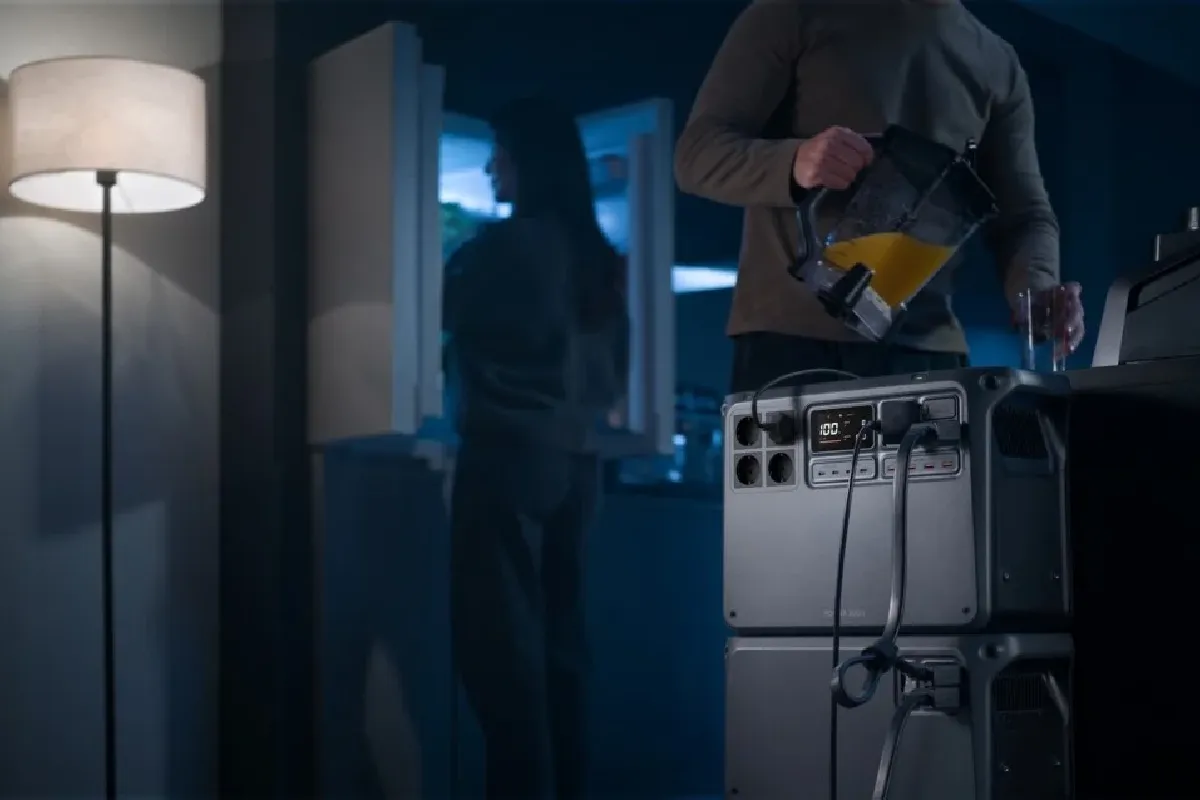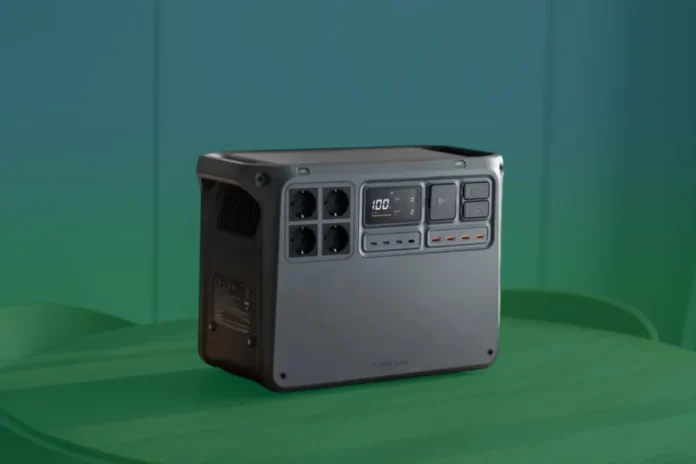DJI, a name synonymous with aerial innovation, has now turned its expertise to ground-level energy with the revolutionary DJI Power 2000. This article explores how this new portable power station is set to redefine energy independence for everyone from outdoor adventurers to eco-conscious households.
What happens when the undisputed master of the skies turns its attention to conquering the ground? For years, DJI has empowered creators and adventurers with its world-leading drone technology. Now, it’s channeling that same innovative spirit to solve one of today’s most fundamental challenges: the growing need for reliable, go-anywhere power. In an age where our outdoor adventures, professional creative workflows, and even our basic home security depend on staying charged, the demand for off-grid energy has never been greater.
This article provides an in-depth look at DJI’s bold answer: the new Power 2000 portable power station. We will dissect its game-changing performance and specifications, from its massive capacity to its revolutionary recharging speeds. We’ll then place it in a head-to-head battle with its top market competitors, highlighting its unique advantages. Finally, we’ll put its immense power into a surprising new perspective by comparing it to the battery of a Renault Zoé electric car, exploring its true potential in a world demanding versatile, mobile energy.
A New Horizon for DJI: More Than Just Drones
For years, DJI has been the undisputed leader in civilian drones and creative camera technology, empowering creators to conquer the skies. Now, with an innovative and strategic pivot, the company is bringing its considerable expertise down to earth. The launch of the DJI Power 2000 marks its bold entry into the highly competitive portable power station market, a move that leverages years of refinement in high-performance battery technology. This isn’t just a new product; it’s a logical evolution, translating the power, reliability, and sophisticated engineering demanded by their aerial products into a solution for terrestrial energy needs.
Upon unboxing, the Power 2000 immediately conveys a sense of premium, durable quality. Its sturdy, flame-retardant casing and clean design feel robust and well-engineered, typical of the DJI brand. With all ports and a bright, easy-to-read display integrated on the front, the layout is intuitive and user-focused, designed for easy access even in the confined space of a van or tent. While its 47-pound (just over 21 kg) weight is substantial, it speaks to the unit’s durability and massive capacity.
The DJI Power 2000 is engineered for a diverse audience united by a common need for reliable, portable energy. It’s a game-changer for professional drone operators, who can now dramatically minimize downtime in the field with specialized fast-charging capabilities. However, its appeal extends far beyond the existing DJI ecosystem. Outdoor adventurers, from weekend campers to long-term van-lifers, will see it as a dependable hub for off-grid living.[7] Likewise, eco-conscious households and tech enthusiasts will value it as a powerful emergency backup and a versatile centerpiece for all their modern devices.

Power and Performance: A Look at the DJI Power 2000’s Specifications
At the heart of the DJI Power 2000’s appeal is a set of specifications that push the boundaries of what’s expected from a portable power station. It boasts a substantial 2048Wh capacity, enough to recharge a professional camera battery over 100 times, power a mini-fridge for more than a day, or keep a complete camping setup illuminated and connected for an entire weekend. With a continuous AC output of 2400W, it can handle not just personal electronics but also demanding power tools and home appliances like microwaves or coffee makers, making it a true workhorse for both the field and home emergencies.
However, its most game-changing feature might be its recharging speed. While competitors can take many hours to replenish, the Power 2000 can be fully charged from a standard wall outlet in a mere 1.3 hours—an incredible feat that minimizes downtime and maximizes usability. For off-grid adventurers, it supports up to 1200W of solar input, allowing for a full recharge in under three hours with optimal sunlight, ensuring energy independence is always within reach.
This raw power is delivered with exceptional versatility. The unit is a central hub for connectivity, equipped with multiple AC outlets, high-speed USB-C ports for modern laptops and tablets, and standard USB-A ports for other gadgets. Furthermore, its capacity is expandable with additional battery packs, allowing users to tailor their energy reserves to specific needs. This combination of high capacity, powerful output, rapid charging, and extensive connectivity makes the DJI Power 2000 a remarkably comprehensive and forward-thinking energy solution.
Sizing Up the Market: DJI Power 2000 vs. Competitors
DJI is not stepping into an empty arena. The portable power station market is fiercely competitive, with established leaders like EcoFlow and Jackery setting high standards. In a head-to-head comparison, the DJI Power 2000 proves it’s a top-tier contender. Its 2048Wh capacity and 2400W output place it squarely alongside flagship models like the EcoFlow DELTA 2 Max and the Jackery Explorer 2000 Pro. Where DJI aggressively pulls ahead, however, is in its charging technology. The ability to recharge from 0 to 100% in just 1.3 hours via a wall outlet is a significant advantage, often cutting charging time by half compared to some rivals.
However, the Power 2000’s true trump card is its seamless integration into the DJI ecosystem. For the brand’s massive user base of drone pilots, this is a revolutionary feature. Using dedicated SDC (Super-fast Charging) ports and proprietary cables, the Power 2000 can fast-charge select DJI drone batteries in as little as 30 minutes. This capability transforms a day of shooting, drastically reducing the downtime spent waiting for batteries and allowing for more airtime. No other power station on the market can offer this level of native support, making it an almost indispensable tool for professional creators and serious hobbyists invested in DJI gear.
In a balanced assessment, while competitors may offer similar core specs in terms of capacity and output, they cannot match this unique ecosystem advantage. For the general user, the decision between the DJI Power 2000 and its rivals will likely come down to factors like price and specific port needs. But for any DJI drone operator, the integrated fast-charging function presents a compelling, and likely decisive, reason to choose the Power 2000.

A Unique Benchmark: The DJI Power 2000 vs. The Renault Zoé’s Battery
To truly appreciate the immense energy stored within the DJI Power 2000, it helps to step outside the world of personal electronics and look at a much larger scale: the electric vehicle. A popular EV like the Renault Zoé, for instance, is equipped with a battery pack of around 52kWh. By comparison, the DJI Power 2000’s 2.048kWh capacity is roughly 4% of the car’s total. While this highlights the massive energy requirements of an EV, it also puts into perspective just how potent modern portable power stations have become.
This comparison isn’t merely academic; it has a practical, if niche, application. While you won’t be fully charging your car with it, the DJI Power 2000 can function as a crucial emergency lifeline. By plugging in an EV, a user could add approximately 5-7 miles (8-11 km) of range to a car like the Zoé. This may not seem like much, but in a critical situation, it could be the difference between being stranded on a remote road and safely reaching the next town’s charging station. It’s a powerful demonstration of the unit’s robust output capabilities, handling the high draw of an EV charger.
This capability signals an exciting intersection between portable and automotive power technologies. As more people adopt electric vehicles for adventure and travel, the role of high-capacity power stations like the Power 2000 evolves. It becomes more than a device for charging drones and laptops; it transforms into a key piece of an integrated energy strategy for the modern explorer, providing a vital layer of energy security and peace of mind, no matter how far off the beaten path they venture.
Conclusion: The Final Verdict on the DJI Power 2000
From the skies to the ground, DJI has successfully translated its engineering excellence into a formidable new domain. The Power 2000 is not just another battery; it’s a statement. We’ve seen how its massive capacity and groundbreaking 1.3-hour recharge speed set a new industry benchmark. While it stands shoulder-to-shoulder with top competitors in raw power, its true masterstroke is the seamless, ultra-fast charging integration for DJI drones—a unique advantage that transforms creative workflows. The surprising ability to provide an emergency charge to an EV further underscores its robust and versatile design.
Ultimately, the DJI Power 2000 confidently answers the call for a more capable and efficient portable energy solution. For the dedicated DJI user, it is nothing short of revolutionary, making it an almost essential purchase. For all other adventurers and tech enthusiasts, it represents the cutting edge of what’s possible, pushing the entire market forward. This launch signals a future where our creative and outdoor pursuits are no longer limited by the life of our batteries, but are instead fully powered by innovation.




